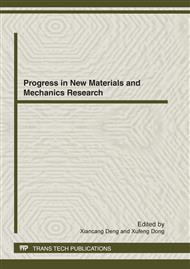p.7
p.12
p.17
p.23
p.31
p.36
p.41
p.46
p.51
Properties of Polyaniline with the Doping of Different Acid
Abstract:
Polyaniline(PANI) with the doping of hydrochloride(HC1), aminosulfonic acid (NH2SO3H) or dodecylbenzenesulfonic acid(DBSA) was prepared by in-situ polymerization. Effects of acid content, reaction time, oxidant ammonium persulfate (APS) dosage and reaction temperature on the conductivity of PANI were studied. The resistance and thermal stability of them were compared. Results show that the largest conductivity of HC1-PANI is 1.98 s.cm-1 among them in case the C(HC1)=0.5mol/L, reaction time is 6.0h, n(APS/aniline)=1.0; The conductivity of NH2SO3H-PANI is 0.2s.cm-1 in case the C(NH2SO3H)=1.0mol/L, reaction time is 6.0h, n(APS/aniline)=2.0; The conductivity of DBSA-PANI is 0.98s.cm-1 in case the C(DBSA)=1.0 mol/L, reaction time is 8.0h, n(APS/aniline) = 2.0. The the least resistance of HC1-PANI is 10Ω, and that of NH2SO3H- PANI is the largest of 120Ω. The order of their thermal stability is DBSA-PANI > NH2SO3H-PANI > HC1-PANI before 350°C, that of their thermal stability is inverse when it reaches 350°C.
Info:
Periodical:
Pages:
31-35
Citation:
Online since:
April 2012
Authors:
Keywords:
Price:
Сopyright:
© 2012 Trans Tech Publications Ltd. All Rights Reserved
Share:
Citation:


